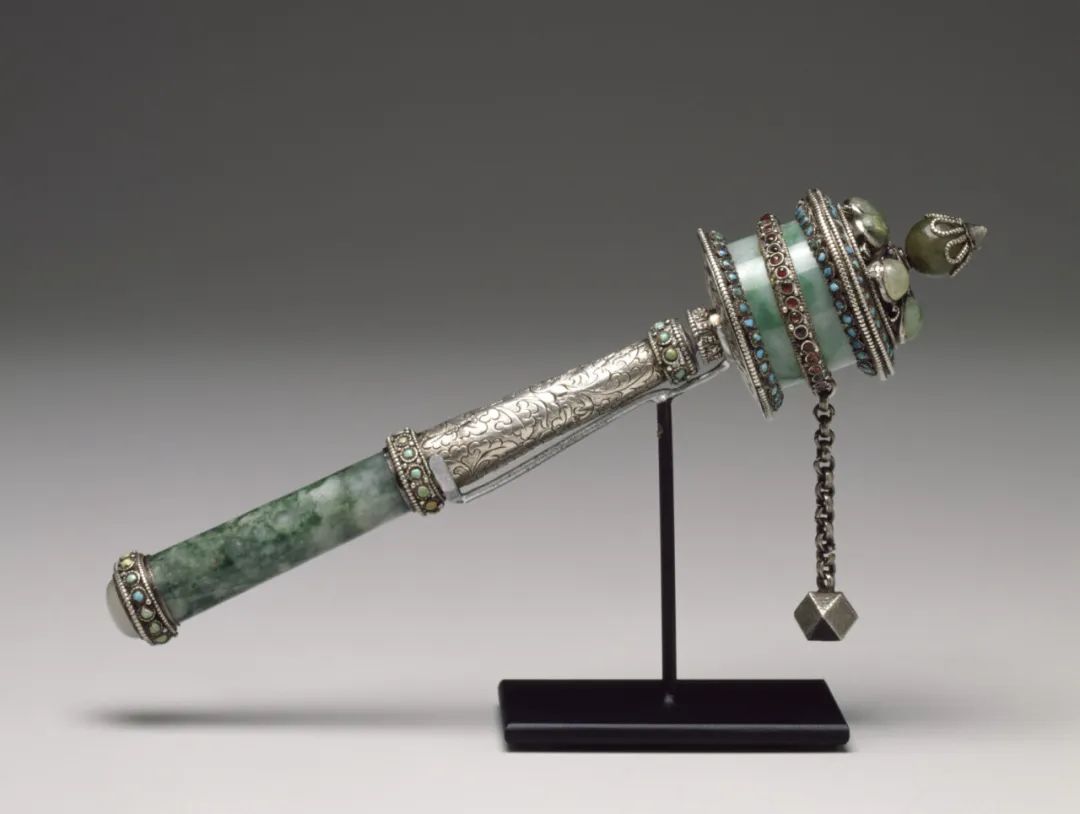
Prayer wheel in Himalayan art ▎Please do not hesitate to turn it

"Eight Treasures Decorated Orchid Paperweight with Rotating Prayer Wheel"
Mid-18th century, private collection

"Five Buddha Figures with Orchid Inscriptions Holding Prayer Wheels"
Part ivory material, early 19th century, private collection
The commonly used script on prayer wheels for writing sacred mantras is called Lantsa. This script, which dates back to at least the 11th century, is prevalent in the Buddhist community in the Kathmandu Valley. Lantsa has a strong decorative and symbolic nature.
When I first saw it being rotated,
I only felt boredom and annoyance.
As time passed, round after round,
I started reciting the six-syllable mantra.
Witnessing the vivid image of Guanyin,
Light began to radiate from within me.
Philip Denwood (1941- ) is a British Tibetologist and prominent socialist.

"The Rotating Axle and Mantra Scrolls Inside the Prayer Wheel"
Private collection, 12th to 13th century
When you walk around the pagodas and temples with a prayer wheel in hand, the ancient syllables you recite form a palace filled with powerful mantras, sitting in this deep state will force you to start focusing your attention. An action repeated hundreds, thousands, or even millions of times; a prayer chanted until it becomes countless - this practice, known as "plural practice", was originally taught by the Buddha to the lazy dragon race (seemingly a specific narrative within Buddhism). While the wise study vast scriptures on Buddhist philosophical systems, ordinary beings trapped in the three poisons rarely have the opportunity to systematically engage with these texts revealing profound teachings. Can texts be compressed or simplified in some way? People urgently need a sense of participation in practice, a reasonable way to awaken and cultivate inner experiences.
Today, people's expectations have been simplified into accumulating merit, that is, eliminating karma to avoid falling into the lower realms while also protecting and blessing all sentient beings. The essence of mantra practice lies in having great reverence for the power of speech wisdom, believing that one's own aspirations to the yidam can shape a visualized object. When the yidam composed of mantras appears in the mind, people no longer need to perceive the essence of wisdom through reading numerous scriptures. The Sakya tradition's omniscient Kunga Sangpo (1429-1489) also refers to mantra practice as the "supreme dharma bestowed by the Buddha out of compassion." The laziness of sentient beings needs to be gently treated as well.

"Hand-held Prayer Wheel", late 19th century
Collection of the National Museum of Asian Art

"The Wind-powered Prayer Wheel", early 20th century
Collection of the Newark Museum, USA

"Ivory Hand-held Prayer Wheel"
Early 20th century, Nelson-Atkins Museum of Art
It is difficult for us to determine the exact time when prayer wheels (མ་ཎི་འཁོར་ལོ་/སྔགས་འཁོར་མ་) appeared. In general, there are three models in the academic community for the origin of prayer wheels. The first model considers prayer wheels as a product of the combination of daily labor practices in Tibetan areas and individual spiritual practice, that is, a collective innovation arising from the spiritualization of life. Some scholars who originally held this view further consider prayer wheels in a broad sense as a product of the combination of indigenous religion in Tibetan areas and the worship of Buddhist mantras, similar to the Tibetan proverb "turning mountains, turning lakes, turning mantras". Although similar objects to prayer wheels have appeared in Tibetan scriptures like the "Mani Collection," their early role differed slightly from the prayer wheels used in later times: early prayer wheels were more like symbolic objects (decorative and cumbersome), rather than practical tools used in spiritual practice.
The last type of origin model attributes the design of Tibetan prayer wheels to the octagonal rotating bookcases used in East Asian Buddhism. Monks attempted to equate the act of rotating the bookcases with the reading of entire scriptures. This may not have been a leisurely activity of some monks in the monastery, but rather a way to distinguish the insights gained from reading texts from the merits generated by default reading. Some scholars even consider this practice as an early Sangha's imitation of the Buddha's "First Turning of the Wheel of Dharma", with hand-held prayer wheels later being a secondary imitation by the laity. It is worth noting that the appearance of giant prayer wheels may not have occurred before the 17th century.

"Avalokitesvara Bodhisattva with Four Arms", 12th century
Ford Family Collection
The Avalokitesvara mantra holds a central place in the Tibetan Vajrayana worship
Most prayer wheels contain the Avalokitesvara mantra as the embedded scripture
ॐ मणि पद्मे हूँ — ཨོཾ་མ་ཎི་པདྨེ་ཧཱུྃ།

"Jeweled Hand-Held Prayer Wheel"
Late 17th century, Walters Art Museum

"Prayer Wheel in Hand", early 20th century
Collection of South Alenyni Art Museum

The practice of verbal wisdom

